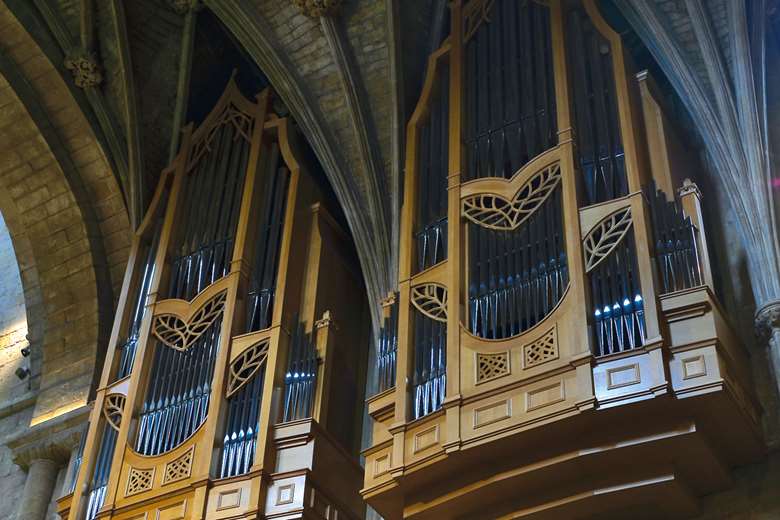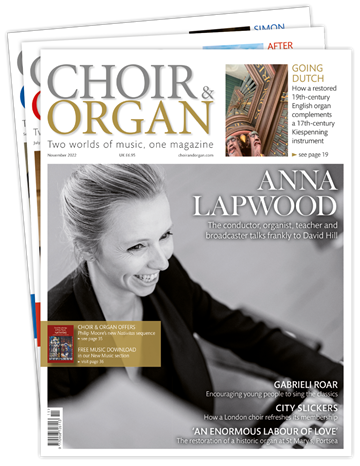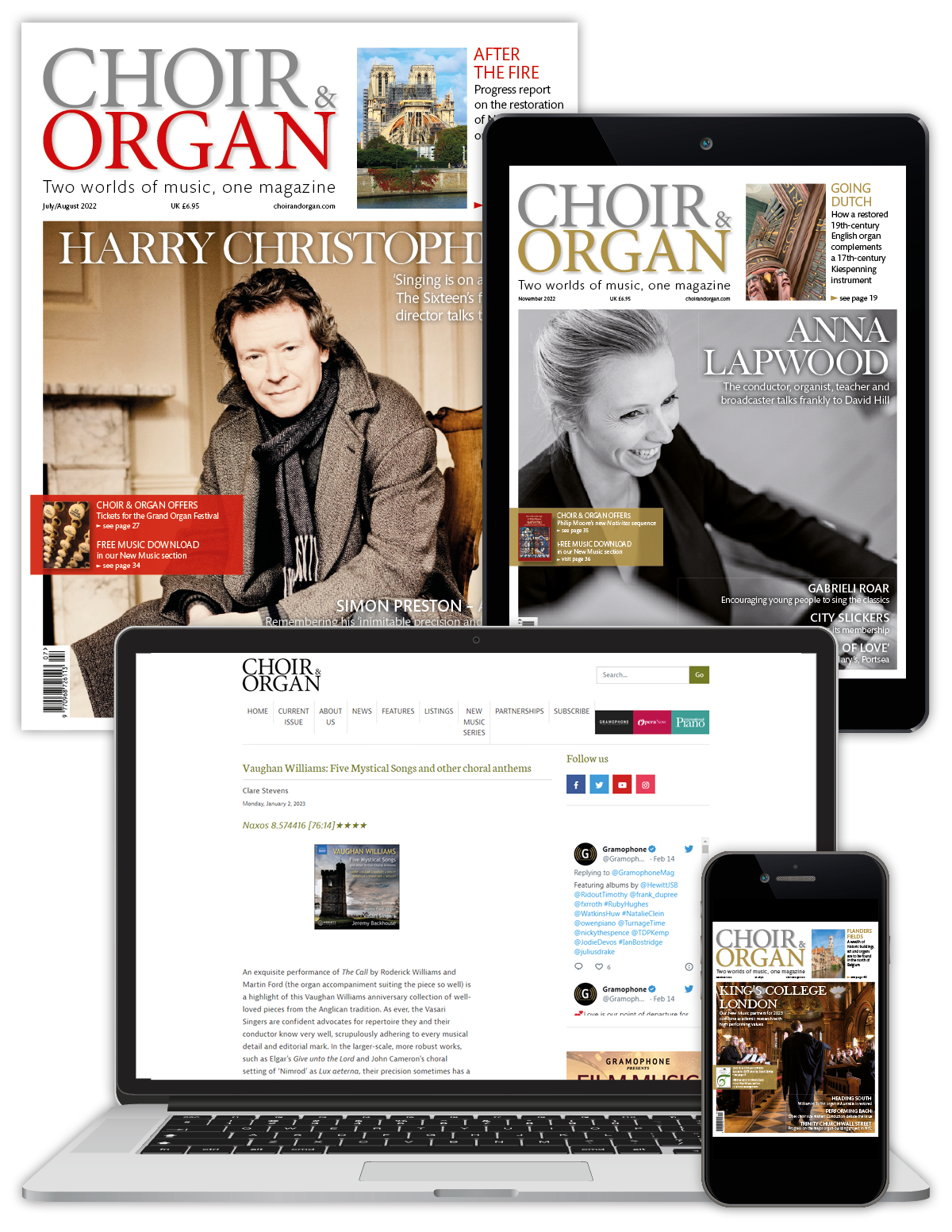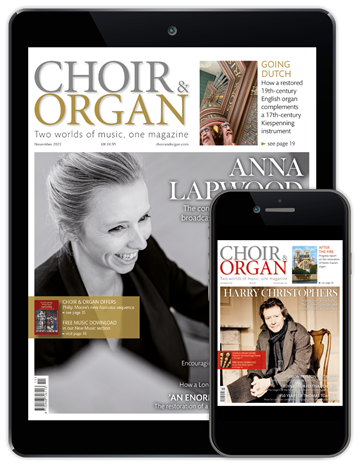Exploring the new organ at Pershore Abbey
Chris Bragg
Tuesday, August 20, 2024
After nearly 30 years without a pipe organ, Pershore Abbey commissioned a new instrument from Fratelli Ruffatti of Padua. Chris Bragg assesses the results

Pershore Abbey in Worcestershire is a beguiling and lovely place. The former Benedictine Abbey bears its scars; the Dissolution saw the destruction of the nave (1540), and the north transept subsequently collapsed (1686). What remains today is the result of a restoration by George Gilbert Scott (1862-65) and consists of a south transept, crossing and choir. This remarkable church features elements of the Norman abbey (1190-1230), while the Early Gothic chancel (the Norman chancel burned in 1223) is famed for its soaring ‘ploughshare’ vaulting. Pershore is also famous for its ‘floating’ ringing platform, Scott having opened up the tower to reveal the internal tracery.
This is an organ in which a singularity of vision is difficult to discern
The modern organ history of Pershore Abbey is similarly turbulent. An undoubtedly fine three-manual 1872 instrument by John Nicholson was rebuilt by Walker in 1940 and 1971. At nearly 50 stops, it occupied the north-east corner of the chancel aisle. Although this can’t have been an ideal location, the organ generated much activity, including a festival in the 1960s under the leadership of enterprising and long-serving organist Rodney Baldwyn.1 In 1996, it was removed, temporarily, to allow renovation works, including the provision of an adjacent fire exit and underfloor heating. Inexpertly stored in the nearby St Andrew’s Centre (a former church) its condition quickly deteriorated. When a further faculty was granted in 2006 for its sale to a church elsewhere, the suitors withdrew. The remains were subsequently sold to another organ builder in ‘a significant breach of the faculty system’, as noted by the Diocesan Chancellor in his response to the retrospective faculty application.2 For some considerable period after its removal, music was provided by an electronic substitute which, again, was intended, as per the terms of the faculty, to be a temporary solution (initially for no more than 10 years). A parallel intention to install a two-manual mechanical instrument petered out amid a shortage of funds and, in the subsequent dozen years or so, various proposals came and went. These included a proposal for a hybrid pipe/digital organ on the west wall to be built by Peter Collins following advocacy from Carlo Curley who was a close friend of the then incumbent.3 Later, similar hybrids were considered for the triforium. Following Curley’s untimely passing, (his memorial service was held at Pershore and his ashes interred in the grounds), a further faculty was applied for to house his touring organ permanently in the abbey.4 The conclusion of this saga, for the time being, has been the 2023 installation of a new organ by Fratelli Ruffatti of Padua.
Active since 1940, the Ruffatti workshop is currently led by the second generation of brothers, who joined the business in 1968. Most immediately associated with large, and in some cases oft-televised, electric-action organs in America, their high-profile installations have included the 350+ stop behemoth at Robert Schuller’s Crystal Cathedral in Garden Grove, California (recently restored by Ruffatti for the now Catholic edifice), Davies Symphony Hall in San Francisco, Spivey Hall in Atlanta, the organ associated with Diane Bish at Fort Lauderdale and more. More recently, a chancel organ at Uppsala Cathedral in Sweden has won admirers, and their first organ in the UK, at Buckfast Abbey, has generated a more mixed response. Having never experienced a Ruffatti in the flesh, I was curious to see how they had responded to the glories of Pershore.
Pershore’s custodians, however, had inherited an unenviable problem. Once the organ was removed from the chancel aisle, and the opening-up of that area had dampened any enthusiasm for a return, no obvious options remained. The west (tower) wall frames a pair of outstanding Victorian stained-glass windows, while an east-end siting would have blocked either Scott’s apse with its narrow lancet window, or above it, the Christ in Majesty standing before the blocked-off windows of the medieval clerestory.
The tender’s expectation that the organ be located in the triforium5 has, on the one hand, permitted an instrument whose sound reaches those below unencumbered. On the other, Ruffatti themselves acknowledged the limitations at the inception of the project: ‘Severe space constrictions exist, which have been determined by the need to reduce the visual impact of the instrument inside the building, in particular by reducing the protrusion of the organ cases to a minimum. In spite of a very creative use of the available spaces, it has been impossible to include in the stop list some stops which would have been desirable under different circumstances, such as an open 16ft Pedal flue stop [or] an additional stop at the Great (a reed stop in particular).’6 The pair of cases stand cantilevered out as far as permissible on steel platforms, the effect slightly like a ‘swallow’s nest’. The decision to put the cases in the westernmost pair of bays maximises the distance from the choir (behind the altar, in front of the apse) and, with the mobile console normally tucked behind a pillar in the north-east corner, means the organist hears the sound reflected off the south wall. It can’t be easy for anyone, although it may permit the organ’s use during events in the crossing. The acoustic, with a decay time of around two seconds, is comparatively diffuse; reinstating the lime plaster removed from the vaulting by Scott and ‘yearned for’ by Simon Jenkins7 might help.
The absences anticipated by Ruffatti feel significant. One might also mention the presence of just one 8ft manual Principal, partly in the façade. This is on the Great and is quite mild with limited treble ascendency or harmonic development. The ensuing chorus, voiced on open toes, is neutrally neoclassical in character, the Mixture providing some ‘point’, the 16ft Bourdon, doing double-duty as a Pedal stop, muddying rather than providing gravitas. It’s all very competently voiced, but neither cohesive nor rich enough to be especially compelling. Even a tierce in one of the manual compound stops would have enlivened. The 8ft Gedeckt might have filled out the Principal to some extent but, surprisingly, it has been voiced with a very prominent third harmonic and sounds distinctly like a Quintadena. This compromises a combined fonds; it remains very audible even when all 8ft flues are coupled, and colours the partnership with the (non-overblowing) Transverse Flute in a rather unconventional way.
With space at a premium, the Positiv, consisting just of flutes, an 8ft Gemshorn and a Cromorne, feels decadent: the result of the organ committee’s requirement for three manuals8 when two might have been wiser. Ruffatti states: ‘This is being designed as a secondary division to the Great, particularly useful for contrapuntal repertoire’,9 but without even a 4ft Principal, let alone a chorus, it’s hard to comprehend how the implied relationship could be fulfilled. The Holzgedeckt has quite a pronounced initial transient, though the remaining flutes don’t follow in train. It seems strange, given the paucity of 8ft stops imposed by the space, that the individual qualities of those present have been prioritised over blend. The Cromorne is, again, competently and evenly voiced. More retiring than its name would suggest, as an unenclosed Clarinet it is a useful colour, if a little thin in the treble; in a récit en taille, balance becomes problematic. The other manual reed (another, ceremonial, stop awaits insertion) is the Swell Trompette Harmonique. Again well finished, its treble is too thin for it to possess any blending qualities to speak of. Given the absence of an Hautbois, it perhaps needed to be more chameleon-like, especially as the enclosure has only a moderate dampening effect. The Swell flutes are perhaps the most successful, especially the signature, tapered Venetian flute in the style of a Callido ‘Flauto in Ottava’. Combined, they form a jeux de tierce which would work well in a tierce en taille, if the tierce extended below tenor C. The 4ft Principal in the Swell is broader in tone than that of the Great and helps better to bind the chorus as a result. The full swell, nevertheless, suffers both from the absence of an open 8ft stop and the individualism of the reed. The strings are calm and smooth with little ‘grit’.
The lack of an open 16ft Pedal stop is keenly felt even if the independent 8ft Octave is welcome. The 32ft Resultant, derived from the Subbass, is a good idea for supporting congregational singing in the absence of an Open Diapason. Closed shallots and a more fundamental-orientated, northern European approach would have helped the extended half-length reed, though evenly voiced, to blend better and be more supportive.
This is an organ in which a singularity of vision is difficult to discern, a feeling emphasised by the variety of languages in the nomenclature. In essence it is a moderately neoclassical instrument, somewhat in the spirit of certain 1960s organs with electro-pneumatic action, schwimmers in the soundboards, and an absence of weight if not exactly of presence. Stylistic comparison with certain instruments voiced by Dennis Thurlow is not entirely irrelevant, though Thurlow, at least sometimes, produced organs of more obvious conviction. Not self-evidently geared to choral accompaniment (either through its location or the lack of 8ft coalescence), it’s not clear either what literature the Pershore organ is intended to facilitate. Ruffatti’s insistence that ‘the tonal design reflects the intention of creating the conditions for the proper performance of the Classical organ repertoire of different styles’,10 is contradicted by both the organ’s essence as an electro-pneumatic instrument with a distant console, and by the console itself which strongly suggests a late-Romantic approach concomitant with the key action but not with the sound palette. Clearly influenced by American practice, this has 61/32 compasses, a coupler rail above the Swell (with unisons, subs and octaves expressed at 8, 16 and 4 respectively), pushing the music desk uncomfortably high even by Henry Willis III standards, radiating/concave pedalboard and plentiful registration aids. The smart wood inlay (and the hardwood parquet floor of the platform) contrasts both with the slightly flimsy-feeling (and small) plastic pistons and with the chrome toe pistons. Indeed, it’s hard not to imagine that the console may quickly feel dated. The plethora of octave couplers creates opportunities for solo colours but cannot mask the fundamental limitations of the concept.
This is an organ which should prompt every bit as much introspection as the altogether more sophisticated, if nevertheless challenged, organ at Peterhouse, Cambridge I described in the previous issue. While at Pershore the absence of an organ for so long, and the intervening, tortuous developments, must have generated considerable frustration, the solution ultimately deemed to impinge least on this most precious of buildings has produced an organ which, while hardly reticent, lacks both core and warmth. Whether or not this was inevitable, certain choices made by Ruffatti with regards to the 8ft stops and to the mid-20th-century ‘neo’ flavour underlying the tonal composition and voicing, seem in some instances to have exacerbated the issues. And herein lie the deeper questions. Given that the organ builders themselves had raised such significant concerns about the lack of available space to build the instrument the client desired, was this really a sensible undertaking? Secondly, while the hundreds of organs produced by Ruffatti provide testament to their commercial success, and the present organ is inarguably competently made and voiced, might this most sensitive of sites not have benefited from a clearer artistic vision? Opinions will differ, but this is an organ which, once again, poses more questions than it answers.
References
1. Musical Times, December 1967, p 1145
2. ecclesiasticallawassociation.org.uk/judgments/organs/pershoreabbey2012.pdf
3. Idem, see also youtube.com/watch?v=pm685MCM3zs
4. ecclesiasticallawassociation.org.uk/judgments/organs/pershoreabbey2013.pdf
5. tinyurl.com/28zuvk3m, p 6
6. The Organ Club Journal 2018/3, p 40
7. Simon Jenkins: England’s Thousand Best Churches, Penguin Press 1999, p 752
8. As note 5
9. As note 6
10. Idem, p 39
Chris Bragg studied organ at the former RSAMD and the Conservatories of Amsterdam and Utrecht. He is head of programming at the University of St Andrews Music Centre, artistic director of St Andrews Organ Week, and a freelance organist, teacher, writer and translator
This article originally appeared in the Autumn 2024 issue of Choir & Organ. Never miss an issue – subscribe today






